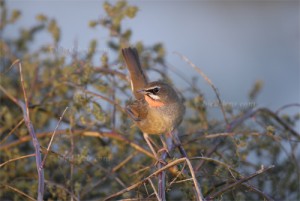 China’s Helgoland? Is there such a thing? Well, it depends on what you consider to be the specific characteristic of the “Shijiu Tuo Island” or “Bodhi Island” (in English simply “Happy Island”) mentioned island.
China’s Helgoland? Is there such a thing? Well, it depends on what you consider to be the specific characteristic of the “Shijiu Tuo Island” or “Bodhi Island” (in English simply “Happy Island”) mentioned island.
Shijiu Tuo Island or simple Happy Island, about 3 hours drive from the seaside resort of Beidaihe located on the Yellow Sea to the east, is at first appearance rather like one of the Northern Sea islands as Texel, Norderney or even Wangerooge. This applies both to the topography as well as the distance from the mainland. Happy Island is not an off-shore island. Therefore it only takes a small boat to bring passengers to the island – in about the same time what it takes to ship from Harlinger Siel to Wangerooge.
Beidaihe is located east of Beijing – about 300 km from the international airport.
The resort has been in the international media at the beginning of August 2012, as this year the Chinese leadership resided in this seaside town to a multi-week retreat to prepare for the upcoming change in power. Previously, the communist party retreats were held regularly in the summer in the nice place. Large parts of the state bureaucracy were carted in the hot months to Beidaihe with its convenient seaside climate. Security is of course very strict at that time but in October / November – the best time for bird migration observation – the resort is very quiet and not crowded. Perfect conditions to go for the beach or in the park adjacent to the Lotus Hills – the Lian Feng Mountain Park – to look after local and migrating birds. So far so good. But now more to Happy Island.
Happy Island at the widest point is only 1.5 kilometers wide and 3.5 kilometers long. Albeit this island offers an impressive diversity of habitats – as does Helgoland. There are grasslands, sandy beaches, small ponds, dense coastal scrub, sand dunes, shrimp ponds and – in the middle a collection of trees that could be almost called a small wood. The wood is picturesquely located right around a Buddhist temple.
The surrounding sea impresses the observer with wide mud flats at low tide. This is an excellent food area for migratory and native birds – such as our North Sea islands. Here waders as Oystercatchers (Haematopus ostralegus), Pacific Golden Plover (Pluvialis fulva), Mongolian Plover (Charadrius mongolus), Greater Sand Plover (Charadrius leschenaultii), Eurasian Curlew (Numenius arquata), Spotted Redshank (Tringa erythropus), Marsh Sandpiper (Tringa stagnatilis), Greenshank (Tringa nebularia), Green Sandpiper (Tringa ochropus) and Dunlin (Calidris alpina) can be seen. Rarities are Pectoral Sandpiper (Calidris melanotos) and finally Far Eastern Curlew (Numenius madagascariensis). One of the highlights is Nordmann’s Greenshank (Tringa guttifer), who is the almost annually observed. Unfortunately I draw a blank on that bird as I missed the Great Knot (Calidris tenuirostris), who is also a scarce passing migrant. A special feature is the observation opportunities for the otherwise very rare Saunders’s Gull (Larus saundersi)  and Relict Gull (Larus relictus). Both could be photographed beautifully. So far, the impressive number of 408 species has been proven for the island, of which only 29 are valid as breeding species and 379 as migratory.
and Relict Gull (Larus relictus). Both could be photographed beautifully. So far, the impressive number of 408 species has been proven for the island, of which only 29 are valid as breeding species and 379 as migratory.
The Fall – from September to mid-November – is a very favorable season for bird watching on the coast of China, since the island is right on the east-siberian flyway and the food supply on the vast mudflats attract many birds migrating from the northern breeding grounds to the wintering areas in more southern climes. If you are lucky, you will find many of the winter guests with breeding species together. Sometimes you are almost overwhelmed by the abundance of species. So much, that it is hard to keep track of all observations. Every morning there is something new – here is a Dusky Thrush (Turdus naumanni), there a Mugimaki Flycatcher (Ficedula mugimaki), the next day a Siberian Rubythroat (Luscinia calliope), then a Orange-flanked Bush-Robin (Tarsiger cyanurus).
A nice selection of bird images of that trip can be seen in the gallery.
A special is the fact that there are at least 10 Buntings (Emberiza species) to observe. You can see Pine Bunting (Emberiza leucocephalos), Tristram’s Bunting (Emberiza tristrami), Chestnut-eared Bunting (Emberiza fucata), Little Bunting (Emberiza pusilla), Yellow-browed Bunting (Emberiza chrysophrys), Rustic Bunting (Emberiza rustica)  , Yellow-throated Bunting (Emberiza elegans), Black-faced Bunting (Emberiza spodocephala), Pallas’s Bunting (Emberiza pallasi) and Reed Bunting (Emberiza schoeniclus).
, Yellow-throated Bunting (Emberiza elegans), Black-faced Bunting (Emberiza spodocephala), Pallas’s Bunting (Emberiza pallasi) and Reed Bunting (Emberiza schoeniclus).
I was happy to experience a trip to Happy Island at the end of October. A 10-day trip in 2007. So far so good with the the character of Happy Island in comparison to the vagrant hotspot Helgoland. What Helgoland does not have are resting cranes. But on Happy Island…….
A longer version of this blog has been published in german by the author in the journal of the “Brehm-fonds” with the name “Zum Fliegen geborgen” resp. “Flying free”, Vol. 30, New Series, No. 1 2012